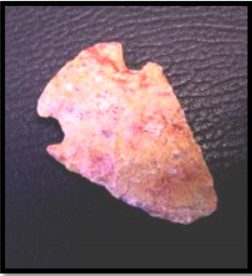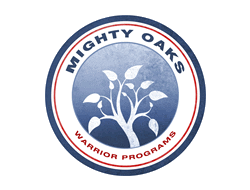THE MYSTERY OF THE ARROWHEAD

The picture before you is a rock I found some forty years ago. In August of 1981 I was hiking through Palo Duro Canyon – a 1000-foot-deep chasm, scoured through the middle of the Texas Panhandle. While crawling on all fours this little 1 ½ – inch rock just popped out at me.
The rock is a flint arrowhead, made by the Comanche Indians who lived in the canyon in the middle of the Nineteenth Century. How do I know it was made by the Comanche? Well, I really don’t know for sure. I’ve always assumed it was Comanche, because in 1874 there was a big battle in Palo Duro Canyon between the Comanche Indians and Colonel Ranald McKenzie’s 4th U.S. Cavalry.
Of course there are some historians out there who will take issue with me. “You don’t know your history, Chaplain. There were also Kiowa Indians who found shelter in that canyon. Now I know my arrowheads and I know that’s a Kiowa arrowhead, not a Comanche.”
Then another person will reply to me and tell, “That arrowhead’s neither, Kiowa nor Comanche. It’s Cheyenne. They were at the Battle of Palo Duro Canyon as well.”
Then I’ll get another reply from someone who’ll remind me, “Bows and arrows weren’t used in the Battle of Palo Duro Canyon. That arrowhead is from an earlier tribe that roamed the Texas Panhandle – the Apache!”
Will the debate never end? Will the makers of the arrowhead remain a mystery? Is there no consensus about the origin of this arrowhead?
Yes, there most certainly is a consensus about this arrowhead. Though we may all disagree on which tribe made the arrowhead, we will all agree on this – it was made by someone. It is not the result of the natural processes of sedimentation, lithification, and erosion.

Why do we all agree that this little rock was fashioned by the hand of man – though it’s crude rather than complex? We recognize this little rock has features of design. Its shape is functional and symmetrical. Its outline has been tooled and sharpened to a serrated edge and this edge comes to a point at its apex – to facilitate the puncturing and slicing of flesh. Its base is flared to prevent the arrow from coming out too easily. It has the distinctive notch that all arrowheads have – to allow the arrowhead to be securely fastened to the arrow with leather or sinew.
The arrowhead is obviously designed to be an effective tool for hunting or fighting. Beyond any reasonable doubt, this little piece of flint is an arrowhead fashioned by a Native American.
But, what about that Native American who made the arrowhead? Is he or she the result of purely natural processes? Does that Native American have any features of design?
Yes, the maker of this little arrowhead most certainly has features of design, incredible and complex design.
Even at birth this Native American already possessed more than 26 billion cells. And by adulthood? As an adult his or her body was made up of between 75 to 100 trillion (100,000,000, 000,000) cells.
Other complex components of the arrowhead’s maker include 1.3 to 1.6 gallons of blood containing 6,000 million, million, million hemoglobin molecules. This blood was being pumped through so many arteries, capillaries, and veins that if they were laid end to end, they’d stretch for about 60,000 miles – enough to wrap around the world twice! This Indian’s body possessed 206 perfectly fashioned bones and over 650 muscles, from the tiny muscles that could move his ears to his largest muscle, the gluteus maximus – the muscle that he sat on. Other features of complex design in the arrowhead maker’s body include 10,000 taste buds in his tongue, palate, and cheeks. They also include his kidneys in which were 1 million tubes – enough to stretch for 40 miles!
Yes, you might not think he was a complex creature for having created so simple a tool, but we’re just getting started. In his spinal cord the arrowhead maker possessed 13.5 trillion neurons (nerve cells); 19 million cells in every square inch of his skin; about 40 million olfactory receptor cells in his nasal cavities to help him smell; a digestive system that worked 12-15 hours digesting each meal; a liver that performed at least 561 known functions to keep him alive, including removing bacteria from the bloodstream, regulating blood clotting, producing bile to digest foods, and storing vitamins and minerals.

The arrowhead maker – whoever he might have been – had a heart that pumped 8,000 gallons of blood every day and beat 2.5 billion times in his or her lifetime. He had a cardio-vascular system that replaced 3 million red blood cells that were lost every second of his life! This primitive toolmaker had DNA molecules that, if unraveled, one would stretch out to almost 80 inches. And if all were unraveled, they would stretch out so long that they could reach to the sun and back again 600 times! And we are only beginning to understand the information storage capacity of these DNA molecules. For even at conception, this single cell contains enough information to fill 200 New York City telephone books of 1000 pages each!
Yes, it certainly took a designer with a brain to make that simple arrowhead. But this Native American was up to the task, since she possessed a brain consisting of an incredible 1,000 trillion connections. These connections conducted electrical impulses for everything from creative thoughts to involuntary body functions.
If we are so convinced that the simple arrowhead had to have a maker, then why can’t we “connect the dots” when it comes to the maker’s Maker? If it took a designer to make the crude, wedge-shaped tool, then it’s simply undeniable that it took a vastly intelligent Designer to make the incredibly complex tool-maker. When faced with the complexity and infinite evidences of design in our own bodies, no thinking person can help but confess, as David did in the Bible, “I will praise You, O God, for I am fearfully and wonderfully made” (Psalm 139:14).
PRAYER: Dear Heavenly Father, remove the blindness from my eyes that keeps me from seeing the obvious – that I am the handiwork of Your infinite intelligence and the art of Your all-powerful and all-loving hands. Amen.







